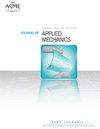板状拓扑互锁结构的挠度极限
IF 2.8
4区 工程技术
Q2 MECHANICS
引用次数: 3
摘要
拓扑联锁结构(TIS)是通过联锁块的几何布置实现稳定性和承载能力的结构组件,仅依靠接触力和摩擦力进行荷载传递。与梁状TIS不同,板状TIS的挠度通常不会超过砌块的高度。然而,板状TIS的挠度上限,这是定义其加载能量容量的关键参数,仍有待探索。在这里,我们建立了板状TIS挠度能力的理论上限,并概述了一个接近该上限的系统设计策略。该策略基于对接触界面进行工程设计,使非中心块体更多地参与结构响应,从而导致具有更高挠度的更全局和整体的变形模式。我们在一个典型的板状TIS的数值案例研究中证明了这种策略的应用,并表明它会导致350%的挠度增加,产生一个比文献中先前报道的更接近上限的值。我们发现,由此产生的偏转模式平等地接合所有块体,避免了局部滑动模式,并且类似于单片等效的偏转模式。最后,我们证明了该策略不仅使TIS的偏转能力最大化,而且使其加载能量能力最大化。本文章由计算机程序翻译,如有差异,请以英文原文为准。
The deflection limit of slab-like topologically interlocked structures
Topologically Interlocked Structures (TIS) are structural assemblies that achieve stability and carrying capacity through the geometric arrangement of interlocking blocks, relying solely on contact and friction forces for load transfer. Unlike beam-like TIS, whose deflection never exceeds the height of the blocks, the deflection of slab-like TIS often does. Yet, the upper limit of deflection of slab-like TIS, a key parameter defining their loading energy capacity, remains unexplored. Here, we establish a theoretical upper bound for the deflection capacity of slab-like TIS and outline a systematic design strategy to approach this upper bound. This strategy is based on engineering the contact interfaces such that the non-central blocks are more engaged in the structural response, leading to a more global and holistic deformation mode with higher deflections. We demonstrate the application of this strategy in a numerical case study on a typical slab-like TIS and show that it leads to a 350% increase in deflection, yielding a value closer to the upper bound than previously reported in the literature. We find that the resulting deflection mode engages all the blocks equally, avoids localized sliding modes, and resembles that of monolithic equivalents. Lastly, we show that the strategy not only maximizes TIS' deflection capacity but also its loading energy capacity.
求助全文
通过发布文献求助,成功后即可免费获取论文全文。
去求助
来源期刊
CiteScore
4.80
自引率
3.80%
发文量
95
审稿时长
5.8 months
期刊介绍:
All areas of theoretical and applied mechanics including, but not limited to: Aerodynamics; Aeroelasticity; Biomechanics; Boundary layers; Composite materials; Computational mechanics; Constitutive modeling of materials; Dynamics; Elasticity; Experimental mechanics; Flow and fracture; Heat transport in fluid flows; Hydraulics; Impact; Internal flow; Mechanical properties of materials; Mechanics of shocks; Micromechanics; Nanomechanics; Plasticity; Stress analysis; Structures; Thermodynamics of materials and in flowing fluids; Thermo-mechanics; Turbulence; Vibration; Wave propagation

 求助内容:
求助内容: 应助结果提醒方式:
应助结果提醒方式:


